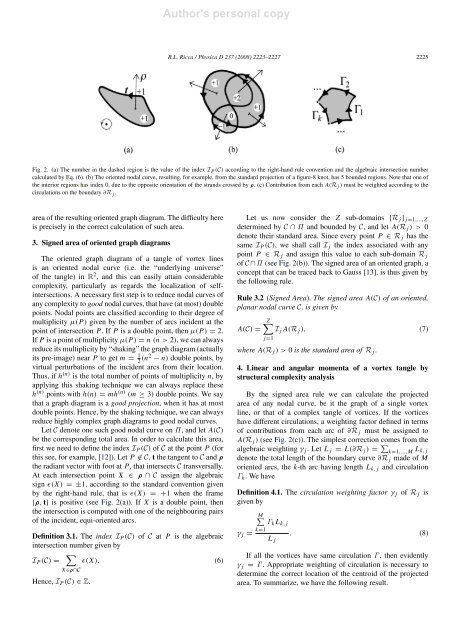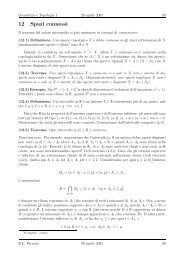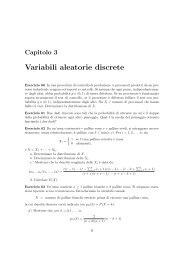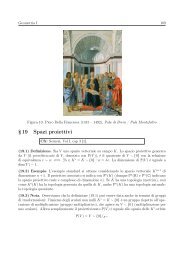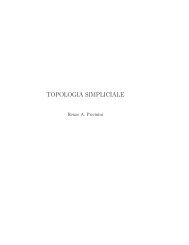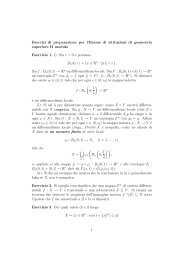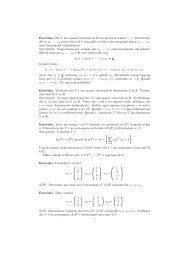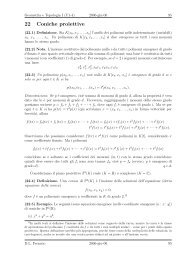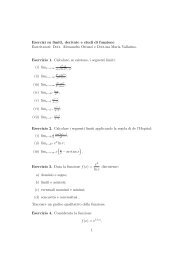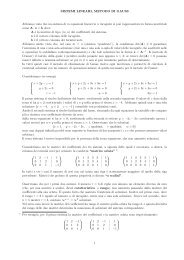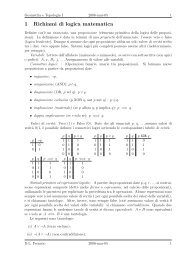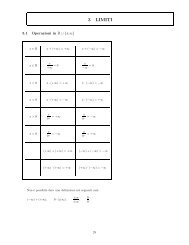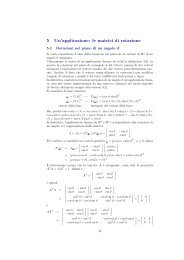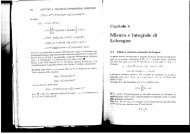Momenta of a vortex tangle by structural complexity analysis
Momenta of a vortex tangle by structural complexity analysis
Momenta of a vortex tangle by structural complexity analysis
You also want an ePaper? Increase the reach of your titles
YUMPU automatically turns print PDFs into web optimized ePapers that Google loves.
Author's personal copyR.L. Ricca / Physica D 237 (2008) 2223–2227 2225Fig. 2. (a) The number in the dashed region is the value <strong>of</strong> the index I P (C) according to the right-hand rule convention and the algebraic intersection numbercalculated <strong>by</strong> Eq. (6). (b) The oriented nodal curve, resulting, for example, from the standard projection <strong>of</strong> a figure-8 knot, has 5 bounded regions. Note that one <strong>of</strong>the interior regions has index 0, due to the opposite orientation <strong>of</strong> the strands crossed <strong>by</strong> ρ. (c) Contribution from each A(R j ) must be weighted according to thecirculations on the boundary ∂R j .area <strong>of</strong> the resulting oriented graph diagram. The difficulty hereis precisely in the correct calculation <strong>of</strong> such area.3. Signed area <strong>of</strong> oriented graph diagramsThe oriented graph diagram <strong>of</strong> a <strong>tangle</strong> <strong>of</strong> <strong>vortex</strong> linesis an oriented nodal curve (i.e. the “underlying universe”<strong>of</strong> the <strong>tangle</strong>) in R 2 , and this can easily attain considerable<strong>complexity</strong>, particularly as regards the localization <strong>of</strong> selfintersections.A necessary first step is to reduce nodal curves <strong>of</strong>any <strong>complexity</strong> to good nodal curves, that have (at most) doublepoints. Nodal points are classified according to their degree <strong>of</strong>multiplicity µ(P) given <strong>by</strong> the number <strong>of</strong> arcs incident at thepoint <strong>of</strong> intersection P. If P is a double point, then µ(P) = 2.If P is a point <strong>of</strong> multiplicity µ(P) = n (n > 2), we can alwaysreduce its multiplicity <strong>by</strong> “shaking” the graph diagram (actuallyits pre-image) near P to get m = 1 2 (n2 − n) double points, <strong>by</strong>virtual perturbations <strong>of</strong> the incident arcs from their location.Thus, if h (n) is the total number <strong>of</strong> points <strong>of</strong> multiplicity n, <strong>by</strong>applying this shaking technique we can always replace theseh (n) points with h(n) = mh (n) (m ≥ 3) double points. We saythat a graph diagram is a good projection, when it has at mostdouble points. Hence, <strong>by</strong> the shaking technique, we can alwaysreduce highly complex graph diagrams to good nodal curves.Let C denote one such good nodal curve on Π , and let A(C)be the corresponding total area. In order to calculate this area,first we need to define the index I P (C) <strong>of</strong> C at the point P (forthis see, for example, [12]). Let P ∉ C, t the tangent to C and ρthe radiant vector with foot at P, that intersects C transversally.At each intersection point X ∈ ρ ∩ C assign the algebraicsign ɛ(X) = ±1, according to the standard convention given<strong>by</strong> the right-hand rule, that is ɛ(X) = +1 when the frame{ρ, t} is positive (see Fig. 2(a)). If X is a double point, thenthe intersection is computed with one <strong>of</strong> the neighbouring pairs<strong>of</strong> the incident, equi-oriented arcs.Definition 3.1. The index I P (C) <strong>of</strong> C at P is the algebraicintersection number given <strong>by</strong>I P (C) =∑ɛ(X). (6)X∈ρ∩CHence, I P (C) ∈ Z.Let us now consider the Z sub-domains {R j } j=1,...,Zdetermined <strong>by</strong> C ∩ Π and bounded <strong>by</strong> C, and let A(R j ) > 0denote their standard area. Since every point P ∈ R j has thesame I P (C), we shall call I j the index associated with anypoint P ∈ R j and assign this value to each sub-domain R j<strong>of</strong> C ∩Π (see Fig. 2(b)). The signed area <strong>of</strong> an oriented graph, aconcept that can be traced back to Gauss [13], is thus given <strong>by</strong>the following rule.Rule 3.2 (Signed Area). The signed area A(C) <strong>of</strong> an oriented,planar nodal curve C, is given <strong>by</strong>A(C) =Z∑I j A(R j ), (7)j=1where A(R j ) > 0 is the standard area <strong>of</strong> R j .4. Linear and angular momenta <strong>of</strong> a <strong>vortex</strong> <strong>tangle</strong> <strong>by</strong><strong>structural</strong> <strong>complexity</strong> <strong>analysis</strong>By the signed area rule we can calculate the projectedarea <strong>of</strong> any nodal curve, be it the graph <strong>of</strong> a single <strong>vortex</strong>line, or that <strong>of</strong> a complex <strong>tangle</strong> <strong>of</strong> vortices. If the vorticeshave different circulations, a weighting factor defined in terms<strong>of</strong> contributions from each arc <strong>of</strong> ∂R j must be assigned toA(R j ) (see Fig. 2(c)). The simplest correction comes from thealgebraic weighting γ j . Let L j = L(∂R j ) = ∑ k=1,...,M L k, jdenote the total length <strong>of</strong> the boundary curve ∂R j made <strong>of</strong> Moriented arcs, the k-th arc having length L k, j and circulationΓ k . We haveDefinition 4.1. The circulation weighting factor γ j <strong>of</strong> R j isgiven <strong>by</strong>γ j =M∑Γ k L k, jk=1L j. (8)If all the vortices have same circulation Γ , then evidentlyγ j = Γ . Appropriate weighting <strong>of</strong> circulation is necessary todetermine the correct location <strong>of</strong> the centroid <strong>of</strong> the projectedarea. To summarize, we have the following result.


